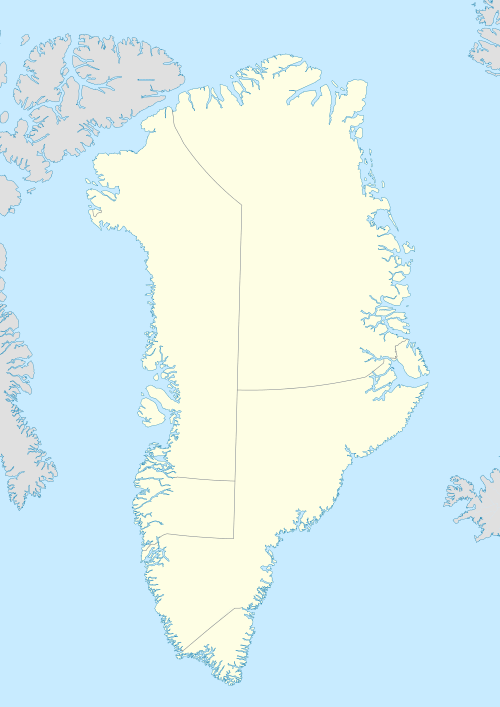Garðar, Greenland
 Harvesting the hay in Vatnahverfi, Garðar | |
 Location of the site in Greenland | |
| Location | Kujalleq, Greenland |
|---|---|
| Coordinates | 60°59′13.56″N 45°25′22.44″W / 60.9871000°N 45.4229000°WCoordinates: 60°59′13.56″N 45°25′22.44″W / 60.9871000°N 45.4229000°W |
Garðar was the seat of the bishop in the Norse settlements in Greenland [1] and is a Latin Catholic titular see.
Diocese of Garðar
In the sagas it is told that Sokki Þórisson, a wealthy farmer of the Brattahlíð area, launched the idea of a separate bishop for Greenland in the early 12th century and got the approval of the Norwegian King. Most of the clergy would come from Norway. The first bishop of Garðar, Arnaldur, was ordained by the Archbishop of Lund in 1124. He arrived in Greenland in 1126. In the same year he started with the construction of the cathedral, devoted to St. Nicholas, patron saint of sailors.[2]
The diocese was first assigned to the German Archbishopric of Bremen. The diocese of Garðar was subject to the Archbishop of Lund (present-day Sweden) from 1126–1152. In 1152 the diocese of Greenland, as well as those of Iceland, the Isle of Man, the Orkney Islands and the Faroe Islands, became suffragan to the newly established Norwegian Archdiocese of Nidaros (Trondheim).[3]
Bishop Arnaldur returned to Norway in 1150 and became bishop of Hamar in 1152. His successor was Jón Knútur, who served from 1153–1186. The third bishop was Jón Árnason (nicknamed Smyrill), who took office in 1189. In 1202–1203 he went on a pilgrimage to Rome and met the Pope. He died in Garðar in 1209 and was buried there, most likely in the Northern Chapel of the cathedral.
The next bishop, Þór Helgi, arrived in Greenland in 1212 and was bishop until his death in 1230. In 1234 Nikulás was ordained, but he arrived in Greenland only in 1239. He died in 1242.
Ólafur was ordained in the same year, but arrived only in 1247. He remained bishop until the mid-1280s. He was abroad from 1264 to 1280, thus hardly serving in his own diocese. The next bishop was Þór Bokki who stayed in Garðar from 1289 until his return to Norway in 1309.
The next one to serve was bishop Árni, who served from 1315 to 1347. Due to the poor communication between Greenland and Norway, it was assumed that he had died and a new bishop (Jón Skalli) was ordained in 1343. When it was discovered that the bishop was still alive, he resigned and never went to Greenland.
After the death of bishop Árni in 1347, it took a long time for the next bishop to arrive, mainly due to the worsening communications. Ivar Bardsson, a Norwegian cleric, served as principal of the diocese during the interim period. Bishop Álfur was ordained in 1368 and served as last bishop of Garðar until 1378. The Greenland diocese disappeared in the 15th century, when the ship departures from Norway stopped.[4] [5]
List of residential Bishops
| Bishop | Served years |
|---|---|
| Arnaldur | 1124–1150 |
| Jón Knútur | 1153–1186 |
| Jón Árnason | 1189–1209 |
| Þór Helgi | 1212–1230 |
| Nikulás | 1234–1242 |
| Ólafur | 1242–mid-1280s |
| Þór Bokki | 1289–1309 |
| Árni | 1315–1347 |
| Álfur | 1368–1378 |
Titular see
In 1996, the diocese was nominally restored as Latin Titular See of the lowest (Episcopal) rank.
So far, it had only one incumbent:
- Edward William Clark, Auxiliary Bishop of Los Angeles (2001.01.16 – ...)
Remains
Presently the settlement of Igaliku is situated on the same location. The site has been the subject of archaeological investigations since the 1830s.The cathedral has been the primary target of much of the archaeological work and was fully excavated in 1926 by Danish archaeologist Poul Nørlund (1888–1951). Nørlund made several scientific studies in Greenland starting in 1921 and ending in 1932.[6]
Many ruins of the Norse settlements can still be seen in Igaliku today. The ruins mostly consist of the stone foundations of the walls in their original positions so that the extent of the settlement, both individual buildings and collectively, can be determined and understood. The main ruin is of the Garðar Cathedral, a cross-shaped church built of sandstone in the 12th century. The maximum length is 27 m, the width 16 m. There are also two large barns on the site with the capacity to have held up to 160 cows.
See also
References
- ↑ Eastern Settlement at Garðar (Igaliku), Greenlan(The Holocene 2009)
- ↑ Gardar, Greenland: Bishops (Discovery Media)
- ↑ Land management at the bishop's seat, Garðar (Antiquity)
- ↑ History of Medieval Greenland
- ↑ Magnus Stefansson. "Ivar Bårdsson, Geistlig". Norsk biografisk leksikon. Retrieved October 17, 2015.
- ↑ Gardar (The Norse History of Greenland 982-1500)
Other sources
- Grønlands Forhistorie (Gyldendal København, 2005) ISBN 87-02-01724-5
- Diamond, J. Collapse: How Societies Choose to Fail or Succeed (pg.232, Viking Press, 2005) ISBN 0-670-03337-5
- Albrethsen, S.E., and J. Arneborg Norse ruins of the southern Paamiut and Ivittuut region (The Greenland Research Center at the Danish National Museum and Danish Polar Center, Copenhagen, Denmark. 2004)
External links
| Wikimedia Commons has media related to Garðar, Greenland. |
